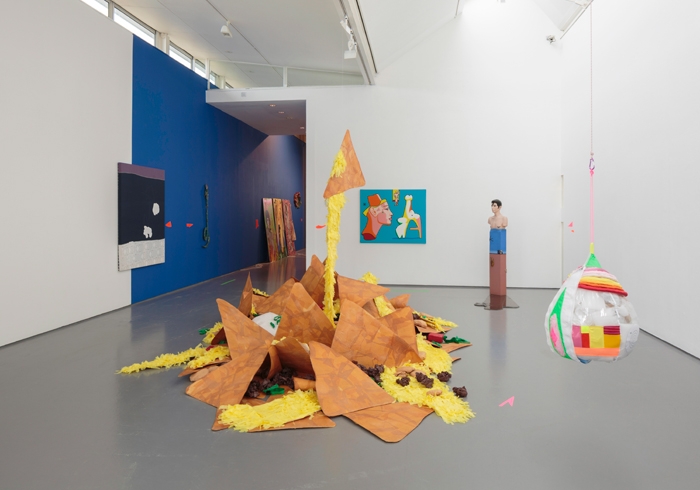Whether the term ‘shonky’ is familiar depends on where and when the reader learned English. The curator of Shonky, artist John Walter, offers a dictionary definition – of dubious integrity or legality; unreliable, unsound – with the intention of exploding these pejorative connotations. In this group show of 14 artists, shonkiness is to be celebrated: amateurish, badly made, tacky, in poor taste and outlandish. ‘With shonky you hover in the middle of not knowing if the work is good or bad,’ Zoë Strachan and Louise Walsh explain in the catalogue essay; ‘shonky is the fake leopard-skin coat of literature.’
There is plenty on display in Shonky to confirm this metaphor’s extension to visual art. More discriminating viewers may not even make it into the gallery space, as the entrance is cloaked with a floor-to-ceiling printed gauze curtain depicting a facade by architect Friedensreich Hundertwasser. Hundertwasser’s buildings are considered by most architectural historians to be in embarrassingly bad taste, with primary-coloured walls and wonky windows like Ikea doing Gaudi. I saw someone shudder at the curtain on entering, a successful outcome for a show that champions transgressions of good taste and received artistic norms.
As far as advancing an ‘aesthetics of awkwardness’, several features recur in the show: lurid colours, sequins and glitter, fragility to the point of collapse. There is also a wealth of softness, embroidery and stuffed toys; Kate Lepper’s soft sculptures are strapped to pillars like awkward, oversize snails. Implicit in this fidelity to DIY processes is a stake in radical politics, drawing on punk, queer and drag aesthetics, and in dissonance with the cultural mainstream. Here, kitsch is reclaimed from the factory-finished quality of a Jeff Koons, and Niki de Saint Phalle’s drawings and small sculptures – mostly of women/animal hybrids – provide a series of joyful encounters with the presiding arch-muse of shonkiness.
Painted in desktop-blue and greenscreen green, the walls and plinths seem to revolt against the idea of the conventional white cube. Walking through the galleries is a frenzied, apophenia-inducing but somehow benign experience; installations by Benedict Drew and collective Plastique Fantastique incorporate film, cultlike murmuring audio and detritus that indicate rituals have taken place. Yet tangible through this occult veneer are familiar anxieties of the self and the state as shaped by capitalism. Collectively, the components of Drew’s Dyspraxic Techno (2017) overload the visitor’s faculties; taken individually, they are harmless, almost pathetic in their ability to cause distress: a hand-painted declaration of ‘Excell Spread Sheet Horror’, and a circling projection that reads ‘hand eye coordination fuck off’.
Shonky is notable for its generational sweep of artists, from the canonical Saint Phalle, to those fallen out of artistic vogue like Andrew Logan, Louise Fishman and Duggie Fields, to Walter’s own peers – including Drew and Lepper, as well as Tim Spooner and Justin Favela. This is a deliberate gesture; in an interview about the show, Walter describes his need to create a context for his own work, to assemble an alternative canon and art history. In this respect, Shonky is a riotous success; as a Hayward Gallery touring show selected from an open call, time will tell whether shonkiness makes a dent in the cultural status quo, or how far, as aspects of drag culture have been recently, it will be welcomed into – and politically diluted by – the mainstream.
Shonky: The Aesthetics of Awkwardness, Dundee Contemporary Arts, through 27 May; Bury Art Museum and Sculpture Centre, 23 June – 15 September
From the May 2018 issue of ArtReview
